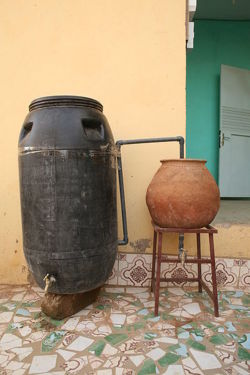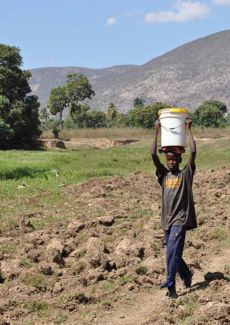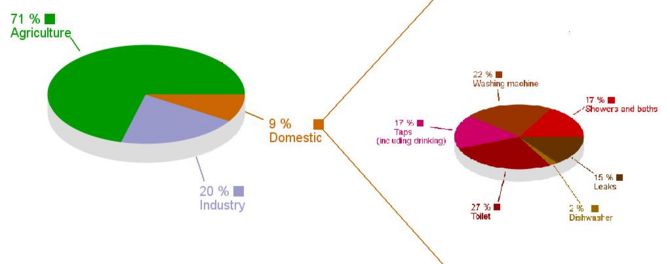Water
 ) expected to grow by 70% [1], rivers becoming polluted and one in eight people already without clean drinking water [2], some have warned that we are heading for a 'peak water' crisis with people lacking the necessary water to survive, and wars breaking out over the access to water supplies [3]. Already, about half of all infectious disease is caused by contaminated drinking water.
) expected to grow by 70% [1], rivers becoming polluted and one in eight people already without clean drinking water [2], some have warned that we are heading for a 'peak water' crisis with people lacking the necessary water to survive, and wars breaking out over the access to water supplies [3]. Already, about half of all infectious disease is caused by contaminated drinking water.
A grim picture, indeed. But fortunately, an entirely avoidable one. Water is one of the most abundant resources available to us on this blue planet. The only problem we may face is synthetic scarcity; this article aims to show that there is no real shortage of water, nor of techniques to purify and manage it. If we simply apply the water-management techniques — many of which are extremely simply, low-tech, low-cost things — we have all the water we could ever need.
Contents
[hide]Abundance of water
Over 70% of the surface of the Earth is covered by water, with the average depth of the oceans being 3.8 kilometres (12,430 ft) – we live on what is primarily a water world. Wasting the fresh water that falls on the surface of the land should of course be avoided wherever possible, but having enough fresh water in any place ultimately comes down to energy, rather than water itself — energy to transport water and energy to purify it. If energy is abundant, then pure water is abundant.
A decentralized water system
As noted above, the challenge of supplying water is twofold:
- Having the energy and infrastructure to transport it
- Having the energy and infrastructure to filter it
If water is produced on-site, the energy needed to transport it is reduced to nearly zero.
The vast potential of rainwater harvesting
The solution to the 'water crisis' is very obvious — we should use the distilled water that falls on our homes instead of diverting it into gutters. This way, water need not be pumped across long distances, which saves the energy needed to transport it and the considerable losses to leaks, which are typically 30% or more. There is rainwater and other impure water in adequate quantities nearly everywhere where there are people. We need to grab this water instead of laying pipes or spending hours a day carrying water.In just about any climate, all the water you need falls on your roof. Suppose you live in a climate that has only 35cm of rainfall per year (which would be classed as a semi-arid climate) and your house is small, with a footprint of 100m2. These are adverse conditions for rainwater harvesting, but such a house would still catch 35,000 liters of water a year, 95 liters a day, which is plenty to cover all domestic use.
A UN report found that rainwater harvesting could supply about ten times what is available from groundwater. Even in cities, where population density is high, the report concluded that rainwater harvesting could meet demand 2-4 times over.
Decentralizing water-production in this way would eliminate the need for a complicated, leaky water-grid and would make people more independent and resilient in the case of disasters.
Cheap, small-scale water filtration

As for the filtration problem, that is being made much easier by some new technologies:
- Nanofilters are one effective way of filtering out both suspended particles (which cause unpleasant tastes, smells and discoloration) and pathogens. The Tata Swach
 is a device that uses nanofilters to give very pure water. It retails for only $21. The LifeSaver bottle
is a device that uses nanofilters to give very pure water. It retails for only $21. The LifeSaver bottle  pumps water through a 25 nanometer filter. This is fine enough to remove viruses and bacteria as well as any particles. Its inventor, Michael Pritchard, has calculated that versions of this technology could provide all the world's water needs for just $20 billion.
pumps water through a 25 nanometer filter. This is fine enough to remove viruses and bacteria as well as any particles. Its inventor, Michael Pritchard, has calculated that versions of this technology could provide all the world's water needs for just $20 billion. - The Slingshot
 , a water filter invented by Dean Kamen
, a water filter invented by Dean Kamen  , can both desalinate and purify water. It is powered by a Stirling engine, which converts ambient heat to work without the need for electricity. Each unit can purify about 1000 liters of muddy water, rainwater, seawater or even urine a day, at a cost of about $0.02 per liter. This would serve the needs of 10-20 people. It is estimated that this technology could provide Africa's clean water needs for $3 billion.
, can both desalinate and purify water. It is powered by a Stirling engine, which converts ambient heat to work without the need for electricity. Each unit can purify about 1000 liters of muddy water, rainwater, seawater or even urine a day, at a cost of about $0.02 per liter. This would serve the needs of 10-20 people. It is estimated that this technology could provide Africa's clean water needs for $3 billion. Biosand filters are remarkably simple for such an effective device; they consist of nothing more than a barrel filled with sand. Gravity and biology do the work without the need for energy use.
Biosand filters are remarkably simple for such an effective device; they consist of nothing more than a barrel filled with sand. Gravity and biology do the work without the need for energy use. - A more low-tech, but equally effective, option is a slow sand filter
 or biosand filter
or biosand filter  . This is essentially a barrel of sand. As water permeates slowly through the sand, particulate impurities are filtered by the sand itself and pathogenic viruses and bacteria that grow in the sand become food for the benign bacterial colonies that grow in the sand. A biosand filter can filter rainwater to potable quality with no energy, no chemicals and no moving parts. They have been shown to remove 98.5% of bacteria from water[4]. They have been shown to operate for at least eight years without maintenance[5]
. This is essentially a barrel of sand. As water permeates slowly through the sand, particulate impurities are filtered by the sand itself and pathogenic viruses and bacteria that grow in the sand become food for the benign bacterial colonies that grow in the sand. A biosand filter can filter rainwater to potable quality with no energy, no chemicals and no moving parts. They have been shown to remove 98.5% of bacteria from water[4]. They have been shown to operate for at least eight years without maintenance[5]
Desalination
The vast majority of mankind's water needs can be met by rainwater catchment. In those few climates where there is not enough rain to meet water demand (such as North Africa and the Middle East) we can create the most vital of human requirements - fresh water - from the most abundant of resources - seawater.
97.5% of Spaceship Earth's water is in its oceans. Though warnings of water shortages invariably dismiss desalination a priori as too expensive or energy-intensive [6][7][8], this is only a valid argument if the energy supply is limited. As long as we have large amounts of renewable energy at our disposal (which we do - see the energy section), we can always create fresh water as required from seawater. Abundant energy means abundant fresh water. Happily, the areas most in need of desalination plants tend to be extremely sunny regions: North Africa, the Middle East, Australia, Mexico etc. These regions are extremely well-suited to solar power and desalination plants set up here could readily power themselves with a few fields of photovoltaic panels.
Moreover, though desalination does require a lot of energy, this requirement is steadily falling as technology improves. Currently large-scale desalination generally uses reverse osmosis  , where seawater is forced under pressure through a membrane. The benchmark amount of energy required for this process is 3.5 kilowatt hours per cubic meter of water p.10. There are several promising technologies which are expected to bring this requirement to 1kWh/m3 or below within the next decade —
, where seawater is forced under pressure through a membrane. The benchmark amount of energy required for this process is 3.5 kilowatt hours per cubic meter of water p.10. There are several promising technologies which are expected to bring this requirement to 1kWh/m3 or below within the next decade —
- Forward osmosis — Forward osmosis pre-treats seawater using a solution to draw some of the salt out of it. This partially desalted water requires less energy to desalinate using a membrane filter. The inventor, Robert McGinnis, has calculated the energy requirements at 0.24 kWh/m3 (p. 18)
- Nanofiltration is an advanced form of reverse osmosis using filters made of carbon nanotubes, which are big enough to let water molecules pass though, but small enough to filter out salt particles, impurities and pathogens. Nanofiltration uses only a quarter the energy of conventional methods of desalination[9]. IBM are conducting research into nanofiltration-based desalination [10].
- Solar desalination
 is a simple and ancient method of desalination that uses no electricity at all, just the heat of the sun to evaporate seawater, which separates the salt from the water. It is only feasible in very hot countries, but these tend to be the ones most in need of water.
is a simple and ancient method of desalination that uses no electricity at all, just the heat of the sun to evaporate seawater, which separates the salt from the water. It is only feasible in very hot countries, but these tend to be the ones most in need of water. - The above technologies could decrease the amount of energy needed for desalination from 3.5kWh/m3 to less than 1kWh/m3. This would be enough to revolutionize the world water system, but there is an even more radical solution which proposes to use no energy at all to desalinate water, but to actually generate electricity from a desalination process. Microbial desalination cells use electrically active microbes to suck sodium and chlorine ions out of the water, simultaneously desalinating water and generating a flow of electrons. A paper published in July 2010 reported that a microbial desalination cell ran successfully for 4 months, removing 99% of salt from water and constantly generating electricity.
Atmospheric water generators
Atmospheric water generators  condense water from the air. This water is clean and ready to drink. It is interesting to note that even very dry air contains about 5ml water per cubic meter of air, so even in a desert, you could condense enough water from the air to sustain a person or to grow food.
condense water from the air. This water is clean and ready to drink. It is interesting to note that even very dry air contains about 5ml water per cubic meter of air, so even in a desert, you could condense enough water from the air to sustain a person or to grow food.
An interesting article by Patrick G. Salsbury analyses the enormous potential of atmospheric water generators to help meet humanity's water needs. He calculates that a device smaller than a microwave oven (using a crude prototype design and a very conservative estimate) provides 110l of clean water a day. Aqua Sciences have a condensor the size of a truck trailer that makes up to 4500l a day - enough for 90 people. Large-scale atmospheric water condensers could be used to generate sufficient water from the air to enable farming in very dry regions.
Microbial wastewater treatment
Microbial fuel cells can be fitted to sewage water treatment facilities to generate electricity. One investigation found that the organic impurities in sewage contain 9.3 times as much energy as is needed to treat the water[11]. It should be possible to integrate microbial energy-harvesting systems with water treatment facilities to create a self-sustaining facility that creates both clean water and clean electricity.
Using less domestic water
In the USA in 2006, the average water use per person per day was 575 litres. Compare this with 149 litres in the UK and 4 litres in Mozambique. 50 litres of water is sufficient for a person[12][13], without requiring sacrifices in lifestyle, just by improving system design. As shown above, even the higher figures can be met by rainwater.
Greywater  is the run-off from showers, sinks etc. It is water that has been used, but is not so dirty it cannot be used for purposes like gardening or washing clothes. Houses can be fitted with greywater recycling systems, where, for example, the output of the shower becomes the input of the dishwasher. This significantly reduces the amount of water needed to run a home.
is the run-off from showers, sinks etc. It is water that has been used, but is not so dirty it cannot be used for purposes like gardening or washing clothes. Houses can be fitted with greywater recycling systems, where, for example, the output of the shower becomes the input of the dishwasher. This significantly reduces the amount of water needed to run a home.
Using composting toilets rather than flush toilets would save 26.7%[14] of water use in the home. Composting toilets are also a source of fertilizer for growing food - and electrodes could even harvest electricity from the bacteria they contain (see Energy).
With the concern about conserving water in recent years, designers have developed toilets, sinks, dishwashers and washing machines that use a fraction of the water used by conventional designs.
However, reducing the domestic use of water is only a small part of the puzzle. Agriculture is the main cause of water use —
See also
- Water-efficient agriculture
- US Geological Survey Survey article about how much water there is on the Earth. The image that goes with it is rather interesting as it shows simultaneously how little (in comparison to the size of the whole planet) yet how much (in real terms) water there is. Put all into a ball, all the water would be about 860 miles in diameter - in between the size of Tethys and Enceladus which are two moons of Saturn [15]



